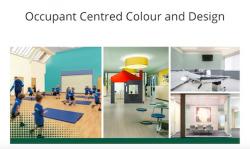Dulux Trade - What is Occupant Centred Colour and Design
 When it comes to design and colour, ‘what looks good’ is no longer enough for clients. People are thinking more deeply about the spaces they live and work in, and they want those areas to feel good too.
When it comes to design and colour, ‘what looks good’ is no longer enough for clients. People are thinking more deeply about the spaces they live and work in, and they want those areas to feel good too.
This shouldn’t come as a surprise.
As people return to public spaces after the Coronavirus lockdowns – they’re all in agreement that they want indoor spaces that improve their health, their happiness, and their wellbeing.
If you want to help your customers achieve the outcomes they have in mind, it’s time to think about what we call Occupant Centred Colour and Design.
But what is Occupant Centred Colour and Design?
“Occupant Centred Colour and Design creates harmony between spaces and people”
Occupant centered design is all about taking the needs of the person using a specific space – the occupant – and putting them at the heart of building design and product choice. Choosing colours and layouts that enhance wellbeing, and using sustainable products that preserve our planet’s natural resources.
Dulux Trade has launched an Occupant Centred Colour and Design hub to inform how expert colour and design application, with the occupant at the heart of the brief, can have a positive impact on wellbeing across a range of sectors, including healthcare and education.
Let’s start by examining how colour affects occupants.
Occupant Centred Colours
The colours used on projects can have a real effect on how people work and live within spaces. Whether it’s by creating a calming space with subtle gradients and pale blue colours, improving concentration and productivity with vibrant greens, or even adding a touch of fun by mixing up colour combinations, there’s a lot that can be achieved with the right colour scheme.
To see how it works in practice, take a look at how the Dulux Trade Commercial Colour Consultants helped the Windrush Academy tackle behavioural issues with occupant centred colour schemes right here.
But with thousands of Dulux Trade colours to choose from, how do you create the colour scheme that’s right for your project?
By using our tools including the Dulux Trade Colour Schemer and Interior Design Moodboard app. They bring together our design expertise and evidence-based research to allow you to offer inspiring, sector-specific colour concepts every time.
Products for Occupant Centred Spaces
The colours you choose are only one piece of the Occupant Centred Colour and Design puzzle. You also need to consider the impact of the products you specifiy, so whether it’s for working or living spaces you are selecting ones that minimise the impact on the occupants themselves.
For example, you can recommend water-based products – such as the Dulux Trade Diamond range or the Dulux Trade Quick Dry range – that are quick drying and low odour.
Or choose new Dulux Trade Airsure paints – which are 99.9% VOC free* , minimising the impact of paint on air quality.
Why Use Occupant Centred Colour and Design Methods?
Occupant Centred Colour and Design is simple enough. It’s a way of working that puts the end user at the centre of everything you do. It’s about the right tools and the right products, combined to give the best outcomes.
But why should you commit to Occupant Centred Colour and Design?
Because it’s what your customers want for their building users. It’s what they expect. It’s what they demand. And by helping to deliver it, you can put yourself ahead of your competitors.
A Wealth of Resources at Your Fingertips
The Dulux Trade Occupant Centred Colour and Design hub showcases industry leading initiatives, piloted alongside industry partners, with case studies, colour advice guides, product recommendations, compliance information, and relevant Dulux Trade tools and support services, all collated to make it easy to apply to an individual project.
So whether it’s for offices, healthcare spaces or schools, using Occupant Centred Colour and Design methods might just be the key to your future success.
For more information visit: www.duluxtrade.co.uk/occd.
* Based on in-can VOC content, measured in accordance with ISO 11890-2:2013.